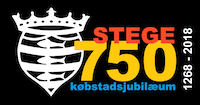Sct. Hans Church, Parish community centre and medieval garden
You could write several books about Morten Reenberg who gave his name to this house and court. Very few have taken such care of his parishioners as he, in every way. When Morten Reenberg came to Stege in 1694 he was 34 years old. He married his predecessor's widow, who was 47 years old and had six children. This meant that he got an office, a wife and six children all at once!
The house was then at least 150 years old and rather in disrepair. Morten Reenberg converted and improved the buildings, enscribing as many as 28 inscriptions above the doors.... to give an example of one above the door to the dining room: ‘The door that everyone knock, will not long be closed’. Or with big black letters on the kitchen wall: ‘New servants have a needle in the bottom, whilst old have thorns in their feet’". And above the door to the audience room: "Go in, talk a little about yourself, bad about nobody, good about all, but preferably about God!’
At that time there was also a breeding farm belonging to the premises. It was located down towards the water west of the main building. Where the barn lay, the earth was quite marshy, so the harvested grain often got mouldy. Therefore, Morten Reenberg determined to move the grain up to the cow stables and the cows down to the damp barn, ‘because the cows better endure standing in water!’ Inside the church you can read a lot more about Morten Reenberg's farm on a large panel of wood.
It should be mentioned, that a large treasure of silver coins was found during the current restorations of the building! It happened the same day as the museum had finished its excavations in the house. The young archaeologist must have been a tad disappointed that he had not made this find himself! The treasure had probably been buried under an outdoor fireplace in the troubled years during the Swedish Wars.
Stege Church - or Saint Hans Church - is one of the country's largest market town churches. In Zealand, only Saint Bendts Church in Ringsted, the Academy Church in Sorø and the Cathedral in Roskilde are larger than Stege’s church. This church was built in the 1200’s by Jacob Sunesøn of the Hvide family. He was probably also in charge of the building of the other red brick churches in Møn: in Keldby, Borre and Magleby. Stege Church originally had twin towers; but these and the church bell crashed to the ground during a fire in 1457.
It shows clearly in both the church's exteriors and interiors that it has been rebuilt several times. You can read more about this story on the Middle Ages information plaque at Møns Bank's parking lot opposite Morten Reenberg’s house. Here, you can also see how the church used to look in the Middle Ages.
Inside the church, you can buy a beautiful and comprehensive brochure explaining all the details. In this, however, one has failed to tell about the mysterious space on the left in the room, just inside the door: during the war in 1940-45, this was walled up and housed the church books and church’s hidden silver!
From the Middle Ages to the beginning of the 1800’s there were burial places, both inside the church under the floor and in the cemetery outside. In both places, however, far too many were buried, and an unbearable stench spread inside the church as well as outside. The cemetery was then moved east of the ramparts, and most of those buried in and around the church were moved.
In a northern niche inside the church, however, there still remain two sarchophagi with the earthly remains of people from the Moltke family at Marienborg. And, in the southwestern niche stands a large sculpture titled ‘Freedom’ enscribed by the sculptor, Bissen. Underneath the steps lies a grave housing several members of the Hage family. On the eastern side of the church square is another memorial to the Hage family. In a time where the church was in lack of financial means, Pastor Reenberg got the splendid idea of making well-paid burial places in the ‘finer end of the cemetery’. Then, the people who had been in lack of prestige in real life could at least rub shoulders with the rich and at the same time contribute a little to the slender church finances!
Now, go through the gate in the part of the church wall adjacent to the parish and church office (in the corner of the church square) and visit the medieval garden. This garden is tended to by volunteer gardeners and was opened in June 2018. In the garden grow medicinal plants, cloves, herbs, etc., and you will find tables and benches where you can sit and enjoy Stege's little oasis.
54.984168, 12.283578
Loading...
This content requires HTML5 with CSS3 3D Transforms or WebGL.



